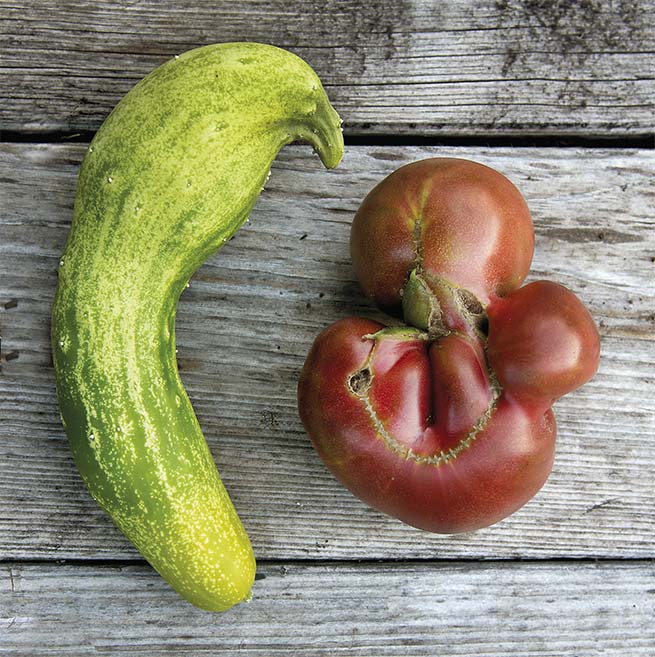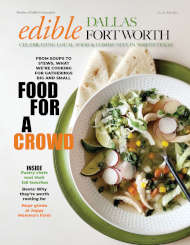So-called “ugly” fruits and vegetables
are finding their way to more tables
around the country—thousands of them.

Photo by Teresa Rafidi
Food-waste fighter Ben Simon, who founded the Food Recovery Network at the University of Maryland in 2011, turned a kernel of an idea into a full-fledged campus movement—with chapters at 150 colleges and counting across the country. The former head of the largest student-run waste-prevention program in the United States has witnessed a sea change in consumer and media awareness on a subject previously relegated to snoozeville status.
“I’ve seen a huge spike in interest in the subject of food waste in the past five years,” says Simon, who now lives in Northern California and co-founded Imperfect in 2015. The start-up sells so-called ugly fruits and vegetables to San Francisco Bay Area consumers in CSA-style boxes, as well as through a partnership with local Whole Foods Market stores.
“When I first started it felt like there were about 10 people focused on this topic. Now it’s hard to keep up with all the new players, innovations and research on the subject. It’s an exciting time. There’s real momentum.”
That’s reflected in Imperfect’s business plan: The company championing cosmetically challenged fruits and vegetables wants to service customers beyond California by the end of 2016; it hopes to be in most major American cities by 2018. On the East Coast, Hungry Harvest currently offers a similar service to the residents of Baltimore, Washington, D.C., and Philadelphia.
It’s not just start-ups, nonprofits and idealistic students jumping on the food-waste-prevention bandwagon. In July 2016, Walmart—America’s largest grocery store chain—piloted a program “I’m Perfect,” selling blemished and dented Washington state apples in 300 Florida stores. This on the heels of the company’s “Spuglies” campaign, which found a market for Russet potatoes roughed up by Texas weather. Both Whole Foods and Walmart have been targeted in Change.org petitions calling the stores out for tossing or turning away funky-looking produce.
Celebrity chefs around the globe have also taken up the cause. There’s top chef Massimo Bottura, of the award-winning Osteria Francescana in Modena, Italy. He led an eff ort to reclaim surplus food from the Athletes’ Village at the Summer Olympics in Rio de Janeiro last year to feed hungry residents of that city’s impoverished favelas. New York restaurateur and “Top Chef” judge Tom Colicchio has taken to Capitol Hill with other fi ne-dining chefs to lobby legislators on the matter.
Last spring, Democratic Representative Chellie Pingree of Maine introduced The Food Date Labeling Act, designed to regulate food expiration labels in an attempt to reduce food waste. Colicchio and his restaurant brethren point to the staggering amount of food that’s wasted in American homes and seek to educate policymakers and the public on how to prevent it. Fellow New Yorker Dan Barber turned his Blue Hill restaurant into the pop-up wastED in 2015, serving fish heads, pockmarked potatoes, whipped chickpea water, burger patties fashioned from juice pulp, and dumpster-dive salad to diners eager to eat well in the name of food-waste prevention.
It’s not just start-ups, nonprofits and
idealistic students jumping on the
foodwaste-prevention bandwagon.
The Salvage Supperclub, for instance,
has hosted dinner parties in garbage
dumpsters in Brooklyn, Berkeley, San
Francisco and Tokyo.
Meanwhile, global media concerns like The Huffington Post have focused on food waste as a worthy cause to cover extensively. And international companies, such as the design and innovation consulting firm Ideo, are crowdsourcing ways to tackle the issue. Educational events featuring menus filled with ingredients that would otherwise have gone to waste are drawing eaters and attention. The Salvage Supperclub, for instance, has hosted dinner parties in garbage dumpsters in Brooklyn, Berkeley, San Francisco and Tokyo.
Food waste is having a moment. And combating the problem is no longer an unfun undertaking. Case in point: witty marketing efforts in Europe, such as the popular program by the French supermarket Intermarché. The grocery chain made ugly hip and hiked sales with its Inglorious fruits and vegetables campaign celebrating produce oddities. The United States is following suit. For example, Giant Eagle stores in Pittsburgh are singing the praises of misshapen potatoes and awkwardly sized apples in its Produce with Personality campaign.
Humor, it turns out, may be a much more effective weapon than guilt in the war against food waste. “People are playing with fun, creative ways to empower people to think about food waste and act,” says Simon. “It’s a good time to capitalize on that energy. This is no longer an invisible issue. With this kind of snowballing effect, there’s the real possibility for significant change to take place.”
TOO GOOD TO WASTE
Fellow food-waste warrior Dana Gunders agrees. “Food is simply too good to waste,” says Gunders, a staff scientist at the Natural Resources Defense Council (NRDC). “Even the most sustainably farmed food does us no good if the food never gets eaten.”
Her message to home cooks is clear and succinct: Just. Do. Something.
We aren’t single-handedly responsible for the country’s food waste crisis and we aren’t single-handedly going to solve the problem, either. But we can all do a better job, says Gunders, of managing our own excess at home. Her focus is waste prevention, not food recovery, and she practices what she preaches. She learned the hard way that beets weren’t her thing: She’d roast them, wrap them and store them in the refrigerator, and promptly forget to eat them. So for now that root vegetable is off Gunders’ grocery list.
Gunders sees ways to avoid food waste at every stage of the food supply chain: from the farm to the fork to the landfill. “Given all the resources demanded during food production, it’s simply critical that the least amount possible is needlessly squandered on its way to our plates,” she says. While it might be convenient to point the finger at Big Ag or Big Business or Big Food Service Providers, the reality is that regular eaters—people like you and me—account for a significant amount of food waste. We are all to blame or, put more gently, we can all be part of the solution.
FOOD WASTE PREVENTION TIPS
- Plan ahead. Use a grocery list to limit impulse buys. Buy less, and buy more often. Factor in no-cook nights. Donate excess to a local food pantry or food-recovery service before it goes bad.
- Store food properly. Potatoes, onions and garlic belong in a cool, dry spot, not the refrigerator. Separate fruit and vegetables in the fridge. Dark leafy greens last longer wrapped in a paper towel or cloth.
- Eat it all. Carrot tops work in salsa verde. Grapefruit peels can be candied. Potato skins make crisps. Veggie scraps add flavor to stock, as do animal carcasses. Stale bread transforms into breadcrumbs. Parmesan rinds add fatty flavor to a pot of beans.
- Understand expiration dates. “Sell by,” “use by,” “enjoy by” and “best before” dates generally indicate when a manufacturer feels a food item is at its peak quality. These labels, largely unregulated, are typically not an indication of food safety. Trust your eyes and nose when it comes to what is still good to eat. Exceptions to this rule include deli meats, unpasteurized cheeses, smoked seafood: In these cases, do follow the “use by” dates.
- Take a fridge inventory. Replenish perishables as you use them up, move older produce to the front of the fridge or top of the crisper when stocking new groceries so you’ll see them before they go bad.
- Keep a kitchen waste diary. Use your phone to track food for a couple of weeks or fill out a wasted-food form, then adjust shopping lists and cooking habits as needed.
- Learn to love leftovers. Pasta, rice, beans, a cooked chicken, roasted veggies can all be reimagined into new dishes. Make it a point to take leftovers for lunch. Designate a night for foraging in the fridge.
- Consider portion size. Keep careful tabs on how much you cook. Watch for plate waste at home and when eating out.
- Befriend the freezer. Store extra pasta sauce, a half loaf of bread and leftovers in the freezer for future use. Label and date containers of sauces, soups and stews—which all freeze well—to jog your memory down the track.
- Grow your own herbs. It’s easy to do, requires little space, and herbs are rarely sold in portion sizes designed for home cooks. Failing that: Turn excess herbs into pesto, chimichurri sauce or herbed butter before they turn to mush in the bottom of the crisper bin.
Source: Dana Gunders
BEST USED: FOOD SAVING
KITCHEN TIPS FOR HOME COOKS
- Give eggs a chance. They can last three to five weeks in the refrigerator regardless of the expiration date. Try this quick test: Place an egg in a cup of water. If it sinks, it’s good to eat. If it floats, it belongs in the compost bin.
- Store fresh basil like fresh-cut flowers. Keep at room temperature with stems in a glass of water; refresh daily.
- Keep whole tomatoes on the kitchen counter. They do best away from direct sunlight, stem end up. This retains the fruits taste and texture, too.
- Sub in sour pasteurized milk. It can fill in for buttermilk in pancakes, waffles or baked goods that call for curdled dairy.
- Soak wilted greens. Put kale, chard, collards, lettuce, spinach and arugula in a bowl of ice water for five to 10 minutes to restore crispness.
- Separate berries. They do best when stored in a single layer in an aerated container or on a cloth-lined tray covered loosely with another cloth.
- Sauté lettuce or mixed salad greens before they go off. Yes, cooked salad greens can be delicious in butter or olive oil with salt, garlic and red pepper flakes.
- Add peeled broccoli stalks to salads. They provide extra crunch and sweetness.
- Use slightly overripe avocados. They add creaminess in smoothies and mousses.
- Infuse vodka. Think softening fruit, citrus peels, fresh herbs, ginger, cucumbers or chile peppers; mix in cocktail of your choice. Cheers.
Source: Waste-Free Kitchen Handbook (Chronicle Books)
FOOD WASTE RESOURCES
Watch. Just Eat It, an entertaining account of wasted food from Canadian filmmakers. foodwastemovie.com
Cook. Root to Stalk Cooking: The Art of Eating the Whole Vegetable by Tara Duggan. Root to Leaf: A Southern Chef Cooks Through the Seasons by Steven Satterfield.
Click. Follow food-waste news and find prevention tips via waste watcher Dana Gunders of the Natural Resources Defense Council. nrdc.org/issues/food-waste
Buy. Imperfect produce for 30% to 50% off retail. Conventional or organic boxes in sizes small, medium, large and extra large. imperfectproduce.com. East Coast: hungryharvest.net
Donate. Find a home for excess edibles through a community food pantry, church or other group.
Volunteer. Pick up or deliver food for food-waste prevention organizations in your area.











